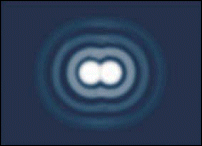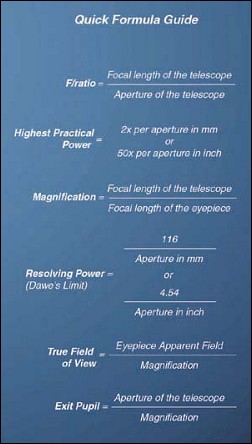Viewing Tips
Telescope Magnifications
 |
| Moon at appropriate magnification under good sky conditions. |
 |
| Above the magnification limit, the image becomes too blurry for useful observing. |
As a general rule of thumb, a telescope is capable of magnifying an object approximately 50x-75x per inch (or 2x-3x per mm) of aperture (objective diameter), so a 4" (100mm) telescope has the potential to magnify approximately 200x-300x. The optical quality, configuration of the telescope and seeing conditions however, will be deciding factors as to what useful magnification a particular telescope can achieve. Atmospheric turbulence usually restricts practical magnifications to a maximum limit of about 300x, or slightly more in rare cases. Above the magnification limit, the image becomes too blurry for useful observing.
It should be carefully noted that for many astronomical observations high magnifications are not necessary and much better results are often achieved by using lower power. The telescopes described in this catalogue are all supplied with various combinations of eyepieces and in some cases a Barlow lens.
The magnification ranges quoted for many of the telescopes in this catalogue are simply those achievable with the standard accessories, and can be increased or decreased as necessary with the addition of the optional accessories that are described later in the catalogue, within the optimum boundaries of the telescopes capability.
Resolution
 |
| The resolving power of a telescope can be described as its ability to separate two closely related stars into their Airy Disks. |
The most important factors in a telescope are the aperture, (or light gathering capability), and the quality and accuracy of their optics. The aperture determines the telescope's ability to resolve small or distant objects and to reveal fine detail. Resolution can be defined as how much detail a particular telescope can see. If the diameter of the aperture is twice as big on a similar quality telescope, then the resolving power should be twice as good. Resolution is stated in arc-seconds and there are sixty arc-seconds in an arc-minute and sixty arc-minutes in a degree.
In short: The bigger the aperture, the higher the resolution and therefore the better the image!!
 * To calculate the magnification using a Barlow lens, use the formula (left) and multiply the result by the magnification of the Barlow lens - x2, x3 etc.
* To calculate the magnification using a Barlow lens, use the formula (left) and multiply the result by the magnification of the Barlow lens - x2, x3 etc.
By using the magnification formula, one can calculate what accessories (eyepieces, Barlow lenses etc.) could be purchased for a telescope to achieve a greater range of useful magnifications than those achievable with the standard accessories supplied.



 * To calculate the magnification using a Barlow lens, use the formula (left) and multiply the result by the magnification of the Barlow lens - x2, x3 etc.
* To calculate the magnification using a Barlow lens, use the formula (left) and multiply the result by the magnification of the Barlow lens - x2, x3 etc.






